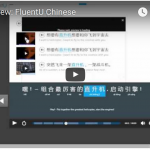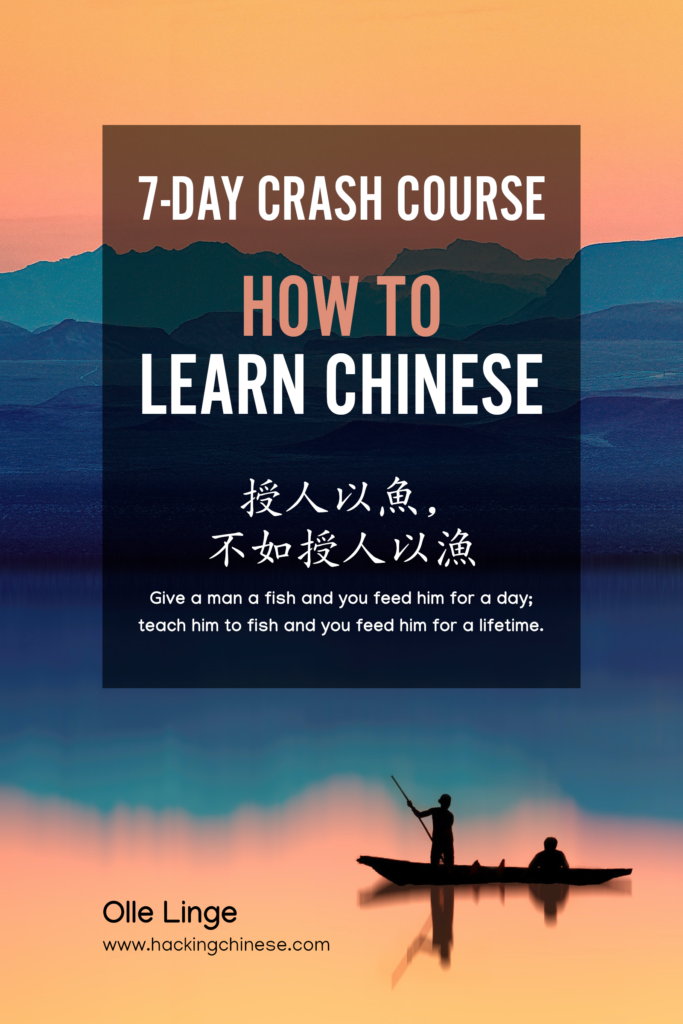 YouTube and similar platforms offer a treasure trove of content that can help you learn Chinese, whether you’re watching videos in Chinese or exploring content about language and culture. But how can you get the most out of this resource at different stages of your learning journey?
YouTube and similar platforms offer a treasure trove of content that can help you learn Chinese, whether you’re watching videos in Chinese or exploring content about language and culture. But how can you get the most out of this resource at different stages of your learning journey?
Tune in to the Hacking Chinese Podcast to listen to the related episode (#216):
Available on Apple Podcasts, Spotify, YouTube and many other platforms!
To answer the question of how to make the most of a resource, you first need to be clear about what you want to achieve. This will enable you to determine what actions to take to get there. There is a lot of content on YouTube that could help you learn, but not all of it will be useful for you and not everything is as useful as it seems.
If you want to learn Chinese, mostly stick to content in Chinese
Below, I have divided potentially useful content into three categories and added some comments about each:
- Learner-oriented content in Chinese: The main problem for most students is that content not produced for them specifically is too hard. Fortunately, many channels focus on content in Chinese aimed at language learners at particular levels.
- Authentic content in Chinese: Once you’ve passed the initial stages of learning, you should start mixing in authentic content. Here, “authentic” means the opposite of “learner-oriented”, in other words, content produced for native speakers. For beginners, this might be limited to music, but as you learn more, the available resources expand too.
- Content in English about Chinese or how to learn Chinese: It’s easy to make the mistake of thinking that learning a language is the same as learning about that language. This is not true. While watching a grammar explanation, listening to a story behind a Chinese idiom, or enjoying a skit about cultural shock, all can contribute to your language learning, the benefits are limited if this is done in English.
Using YouTube to engage with content in Chinese, whether created for you as a student or for native speakers, is great. You learn by engaging with the language directly, through listening or reading.
Using YouTube to learn about the language, the culture or how to learn the language can be useful, but it should make up a small minority of your total study time. For more about balancing your learning, check Analyse and balance your Chinese learning with Paul Nation’s four strands.
Analyse and balance your Chinese learning with Paul Nation’s four strands
How to use YouTube to learn Chinese
As mentioned earlier, YouTube offers a wealth of resources on Chinese language and culture. In this article, I’ll focus on how to approach content in Chinese, regardless of level.
You don’t need guidance on how to watch a video in English about how to mimic native speakers to improve your pronunciation or the history of Chinese fonts, so I won’t discuss those cases here. But yes, my podcast, including the episode based on this article, is available on YouTube:
Just remember what I said earlier: Watching videos largely in English will not do much for your Chinese learning. It might feel good to hear someone help you make sense of an idiom or sort out the difference between two similar words, but this is much less helpful than it seems. Languages are largely learnt implicitly through input.
So, when it comes to input, here’s the general approach I recommend:
- Explore new resources: Spend a small portion of your time exploring new channels and content. Naturally, if you’re not using YouTube now, finding a few channels you like might take a while, but avoid spending too much time browsing and trying to find the perfect resource. I will post a follow-up article later with my recommendations, so please leave a comment if you want to recommend your favourite channel.
 Watch and listen: Depending on the length of the video, watch it in one go or break it into sessions. Watch it without pausing or looking anything up, focusing on general comprehension. If your listening ability matches the difficulty level, try listening before watching. For beginners, visual support is key, so use it if needed. Visual support is also useful for more advanced students tackling challenging content.
Watch and listen: Depending on the length of the video, watch it in one go or break it into sessions. Watch it without pausing or looking anything up, focusing on general comprehension. If your listening ability matches the difficulty level, try listening before watching. For beginners, visual support is key, so use it if needed. Visual support is also useful for more advanced students tackling challenging content. Watch and listen again: Assuming that you have chosen something you’re interested in watching, it’s almost always a good idea to watch and listen more than once. This allows you to understand more as you can focus on different things each time you listen and can rely on what you gleaned from earlier listens in later ones. If you don’t understand the gist even after listening more than once, you need to find something easier.
Watch and listen again: Assuming that you have chosen something you’re interested in watching, it’s almost always a good idea to watch and listen more than once. This allows you to understand more as you can focus on different things each time you listen and can rely on what you gleaned from earlier listens in later ones. If you don’t understand the gist even after listening more than once, you need to find something easier. Use scaffolding: To understand more than the gist, you might need to rely on various types of support. Much of this scaffolding is built-in to YouTube and easily accessible, such as closed captions, and lower playback speed, whereas others might require third-party plug-ins or programs, such as pop-up dictionaries or subtitles converted to Pinyin. More about scaffolding tools later.
Use scaffolding: To understand more than the gist, you might need to rely on various types of support. Much of this scaffolding is built-in to YouTube and easily accessible, such as closed captions, and lower playback speed, whereas others might require third-party plug-ins or programs, such as pop-up dictionaries or subtitles converted to Pinyin. More about scaffolding tools later. Download the audio: One drawback of YouTube compared to podcasts is that unless you have premium, you need the screen on, and an internet connection. This limits when and where you can watch. One solution is to download the videos or download only the audio. This is not possible without third-party tools unless you have premium, and such tools may be against the terms of service, so this is in no way meant to be legal advice. As an example, I have found, downloaded and listened to many audiobooks on the Chinese platform Bilibil.
Download the audio: One drawback of YouTube compared to podcasts is that unless you have premium, you need the screen on, and an internet connection. This limits when and where you can watch. One solution is to download the videos or download only the audio. This is not possible without third-party tools unless you have premium, and such tools may be against the terms of service, so this is in no way meant to be legal advice. As an example, I have found, downloaded and listened to many audiobooks on the Chinese platform Bilibil. Review (on the go): Having audio from videos available while commuting, jogging, or doing chores is a great way to reinforce learning. Add this content to your personal Chinese audio library and revisit it regularly. This is much more likely to happen if you have the audio available wherever you are, including without internet and your device’s screen turned off, compared to if you have to be actively using YouTube.
Review (on the go): Having audio from videos available while commuting, jogging, or doing chores is a great way to reinforce learning. Add this content to your personal Chinese audio library and revisit it regularly. This is much more likely to happen if you have the audio available wherever you are, including without internet and your device’s screen turned off, compared to if you have to be actively using YouTube.
In short, treat YouTube content like any other learning material. Casual watching won’t help much unless you already understand nearly everything. This is realistic for more advanced learners, but the content that truly interests you may still be slightly too challenging for beginners and intermediate learners. Focus mostly on content created for students on your level to get comprehensible input. Listen more than once and use scaffolding when you need to.
Don’t forget Chinese video-sharing platforms
I think this ought to be clear, but the benefits of using YouTube for learning Chinese are not limited to YouTube specifically, and the procedure above works equally well for any video-sharing platform. They have similar features and functions, after all. Beyond exploring Chinese content on the biggest video-sharing platforms internationally, you should also check out major Chinese sites. For obvious reasons, these often have much more content in Chinese, although it might require a higher level to access.
Here are the most popular sites as of 2024:
Scaffold your YouTube experience to understand and learn more
I mentioned scaffolding above and said I’d bring it up more later, so let’s do that! There are several ways to make YouTube content more accessible. For Chinese learning videos, the creator may have already incorporated some of these techniques, but for authentic content, you’ll need some strategies to adjust the difficulty level.
For example, a video for beginners might include slow speech and Pinyin already, but if you’re watching content not aimed at language learners, you need to actively create these. Fortunately, that’s very easy. Let’s have a look!
 Playback speed: YouTube allows you to adjust playback speed. Simply click the cogwheel under the video and select “playback speed”. One of the major hurdles when listening in a foreign language is that processing is not automated enough and will lag behind the spoken language. Slowing down the audio gives you more time to process what’s being said without changing the pronunciation. However, slowing it down too much can make it harder to understand, so be mindful of that too. The sweet spot is usually between 0.75 and 0.95 speed; small adjustments can make a big difference.
Playback speed: YouTube allows you to adjust playback speed. Simply click the cogwheel under the video and select “playback speed”. One of the major hurdles when listening in a foreign language is that processing is not automated enough and will lag behind the spoken language. Slowing down the audio gives you more time to process what’s being said without changing the pronunciation. However, slowing it down too much can make it harder to understand, so be mindful of that too. The sweet spot is usually between 0.75 and 0.95 speed; small adjustments can make a big difference. Closed captions and transcripts: Many videos come with closed captions, either manually added or automatically generated. I recommend turning them off at first if your goal is to improve your listening ability. Listening without reading is harder to come by, but more beneficial in the long run. Once you’ve listened, turn the captions on to clarify any unclear parts. Seeing characters or Pinyin can be particularly useful for tricky sections or for looking up words you don’t know. Naturally, Pinyin is almost never available unless hardcoded into the video, so you need extra tools for that.
Closed captions and transcripts: Many videos come with closed captions, either manually added or automatically generated. I recommend turning them off at first if your goal is to improve your listening ability. Listening without reading is harder to come by, but more beneficial in the long run. Once you’ve listened, turn the captions on to clarify any unclear parts. Seeing characters or Pinyin can be particularly useful for tricky sections or for looking up words you don’t know. Naturally, Pinyin is almost never available unless hardcoded into the video, so you need extra tools for that. Language learning plugins: Plugins like Language Learning with YouTube (Chrome) can make the learning process easier by adding features like dual closed captions and subtitles, as well as pop-up dictionaries and other handy features. These plugins can also make other types of scaffolding mentioned here easier to use or more customisable. YouTube is primarily not designed for language learning, but these plugins are. You can also try paid services like FluentU (free trial) or Language Player (limited free version)
Language learning plugins: Plugins like Language Learning with YouTube (Chrome) can make the learning process easier by adding features like dual closed captions and subtitles, as well as pop-up dictionaries and other handy features. These plugins can also make other types of scaffolding mentioned here easier to use or more customisable. YouTube is primarily not designed for language learning, but these plugins are. You can also try paid services like FluentU (free trial) or Language Player (limited free version)
Naturally, scaffolding has its limits. This isn’t an encouragement for beginners to tackle native-level content at 50% speed with subtitles in Pinyin and a pop-up dictionary. While it’s possible if you’re genuinely interested, it should make up only a tiny sliver of your study time and be reserved for things you are truly interested in. For more ideas on scaffolding your Chinese learning, check out this article: 8 great ways to scaffold your Chinese learning.
The best YouTube channels for learning Chinese
In an upcoming article, I will recommend the best channels I’ve found for learning Chinese. I’m just one person, however, so it’s likely that I haven’t found all the great channels out there. What’s your favourite YouTube channel for learning Chinese? Why? Please leave a comment below!

9 comments
I really like the content created by talkinchinese_redred on YouTube, she travels around china and uses daily vocabulary.
She also narrates some stories so you can find variety on her channel. I study intensevely like five minutes of her videos, and after that I just enjoy the content. Some of them have CC so you can easily study with chrome plugins.
I also like eazy mandarin and dashu mandarin, they create interesting content for intermediate/advanced students. In a good day I can understand some parts of some of their videos, but the level is just too high for me. I still enjoy them now and then, just not on a regular basis.
That sounds great, I’ll check them out! Dashu I know about, assuming it’s the same as the podcast, and I like that one a lot. Thank you for also explaining why you like these channels, as it’s sometimes not obvious at first glance (not in this case, just a general comment that it’s easier for me to evaluate something if I know why it was recommended to me).
Hello Chinese
Dashu Mandarin
Mandarin corner
Everyday Chinese
Chinese Mandarin Cherry
Chinese zero to hero
Thank you! I had most of those on my list, but not all! I’ll make sure to check them when I write the follow-up article.
My top youtube CI creators:
1. Lazy Chinese – her channel like graduated readers but for listening
2. Story Learning Chinese with Annie
3. Blabla Chinese Comprehensible Input
4. Mandarin Corner
5. Several good ones that are no longer updated….
Thank you! I’m interested in channels that don’t update too. Older content is sometimes better and most listener content ages quite well (unless it’s about news or current events, maybe). As long as the channel has more than a handful of videos, I’d be curious which you like, even if they don’t update. I’ve added the others to my list as well!
I like Chinese podcast with Shenglan on Youtube. She recently made a video about a neighbourhood in Changsha which was brilliant.
Thank you for your recommendation! I’ve put her channel on my list. 🙂
My favorite youtube channels (in this order):
1. Lazy Chinese
2. Chinese Mandarin Cherry
3. Story Learning Chinese with Annie
4. Xiaogua Chinese (from her I discovered hackchinese)
5. ShuoShuo Chinese